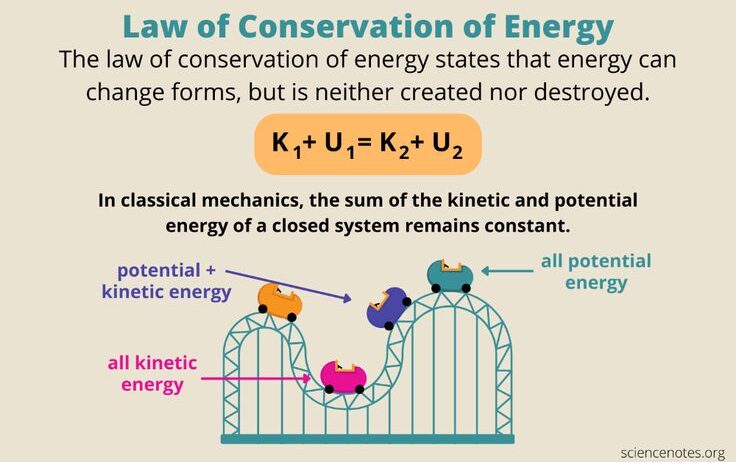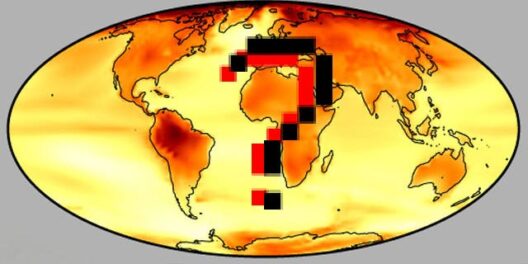The Moon, Earth’s enigmatic satellite, captivates human curiosity not merely for its celestial beauty but also for the profound insights it offers into fundamental physical principles. Among these principles, the law of conservation of energy plays a pivotal role, serving as a cornerstone of both terrestrial and extraterrestrial physics. Understanding how conservation of energy operates on the Moon provides an intriguing glimpse into the complexities of space physics.
At its core, the law of conservation of energy states that energy cannot be created or destroyed; it can only transform from one form to another. Every physical process in the universe adheres to this immutable law. On Earth, we routinely observe this principle; however, the stark and desolate environment of the Moon offers a unique laboratory for examining energy transformations, particularly in the context of its geology, regolith, and microgravity conditions.
One of the most striking observations about the Moon is the absence of an atmosphere. Unlike Earth, which has a thick blanket of gases that facilitates various energy transfers, the Moon’s airless environment drastically influences energy conservation processes. The lack of atmospheric pressure means that heat cannot disperse through convection or conduction as it does on Earth. Instead, heat energy primarily travels through radiation. During the lunar day, temperatures soar, while the frigid night brings them plummeting. This results in extreme variations that underscore the importance of energy conservation.
The lunar surface is composed of a fine layer of regolith—an assemblage of micro-sized rocks and dust. When energy from solar radiation strikes the Moon, it is absorbed by this regolith, raising the surface temperature and affecting the energy dynamics of the environment. However, this heat is swiftly radiated back into space due to the absence of an atmosphere. Here, one can see a clear example of energy conservation: the energy absorbed from sunlight is ultimately transformed into thermal energy, yet rapidly dissipates through infrared radiation. The net balance of energy absorbed and emitted is critical in defining the thermal regime of the Moon.
Additionally, the Moon’s gravitational forces play a significant role in energy conservation within its unique geophysical context. With only one-sixth of Earth’s gravity, the Moon alters the dynamics of potential energy. For instance, any object on the lunar surface possesses less potential energy due to its reduced mass in gravitational fields. When analyzing the potential and kinetic energy of objects released on the Moon, the results drastically differ from Earth. An object dropped from a height will still fall, governed by gravitational pull, but it will experience minimal resistive forces, adhering to the conservation of mechanical energy principles.
This divergence in energy dynamics leads to fascinating conclusions about motion on the Moon. When a hammer and a feather are dropped simultaneously in a vacuum chamber on Earth, they fall at the same rate, as famously demonstrated by astronaut David Scott during the Apollo 15 mission. On the Moon, where almost all external forces are negligible, such experiments reveal intricate details about how objects conserve mechanical energy. The fundamental laws of physics remain consistent, yet the manifestations are dramatically different, leading to an understandable fascination with celestial mechanics.
The Moon’s geological activities further exemplify conservation of energy principles. Although it appears inert, the Moon experiences seismic activities known as moonquakes. These seismic events result from tidal forces exerted by Earth, illustrating another layer where energy conservation is observable. The gravitational interaction between the Earth and the Moon causes energy to be transferred in the form of tidal heating, allowing for processes that reshape the lunar surface over aeons. This energy creates friction, generating heat which can yield alterations in the lunar crust, showcasing the interplay between gravitational potential energy and thermal energy.
Understanding how energy is conserved helps illuminate our comprehension of potential lunar exploration and colonization. For future lunar missions, energy management becomes vital. Solar panels may harness the abundant sunlight, yet storing this energy for use during the lunar night—a time when temperatures can plunge to -173°C—is paramount. Technologies optimized for energy conservation—such as advanced thermal insulation and energy storage systems—will be required to keep habitats functional and support human life during the prolonged darkness.
The notion of energy conservation extends beyond the physical realm and resonates with environmental consciousness on Earth. As scientists ponder the prospects of lunar colonization, the principles learned from the Moon can offer valuable lessons regarding energy efficiency and sustainable practices. The understanding of energy conservation in the barren expanse of the Moon can inform better practices for energy usage and conservation on our home planet.
Intriguingly, the study of energy conservation on the Moon aligns with humanity’s ongoing quest to decipher the cosmos. With each mission back to our closest celestial neighbor, we deepen our understanding not only about the Moon but about the fundamental laws that govern all matter and energy. The Moon continues to serve as a wellspring of knowledge, unveiling the mysteries of energy preservation as its surface remains an eternal witness to the interplay of solar energy, gravitational forces, and the laws of physics that transcend millions of miles. The fascination with how conservation of energy works on the Moon thus evolves into a broader narrative of exploration and discovery, grounded in the pursuit of knowledge and sustainability.






